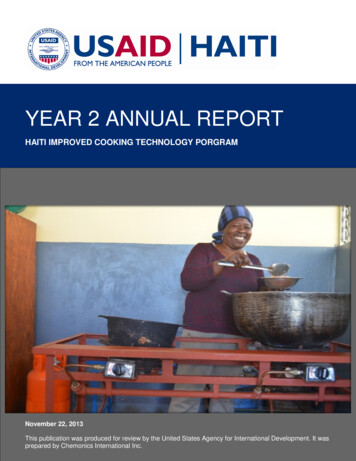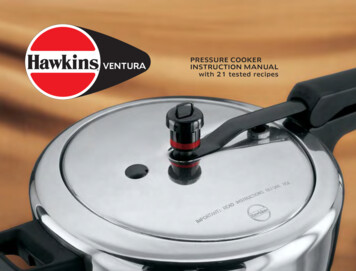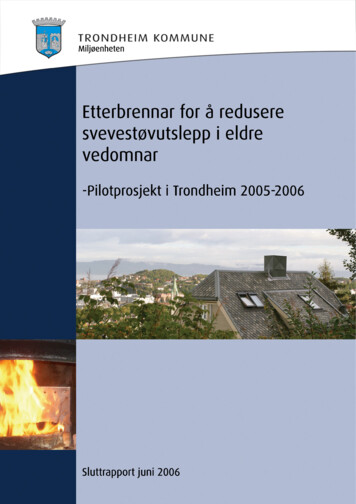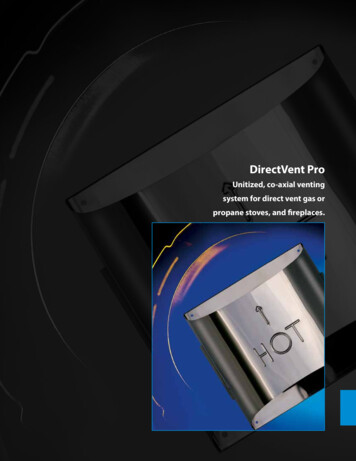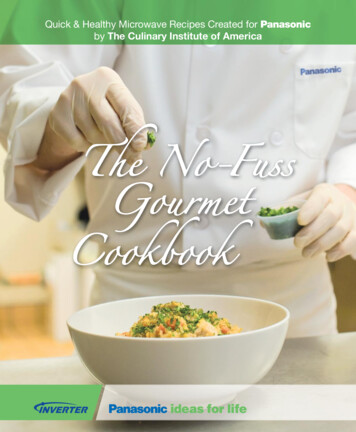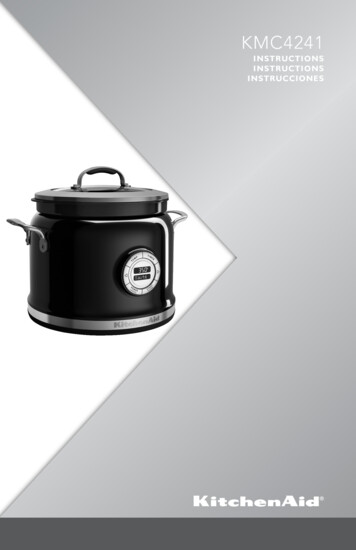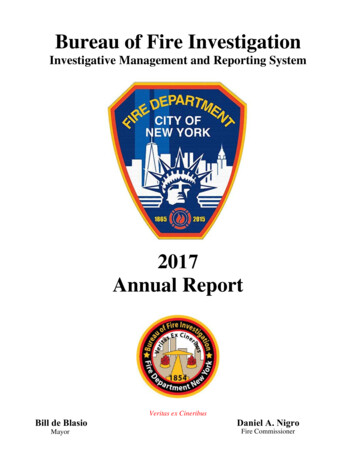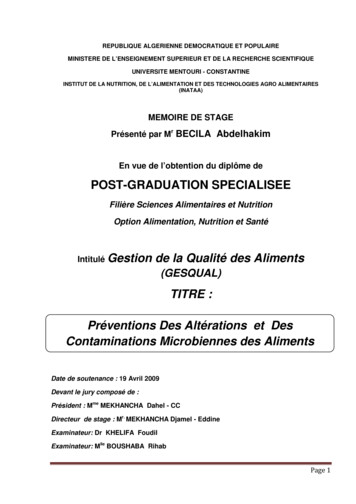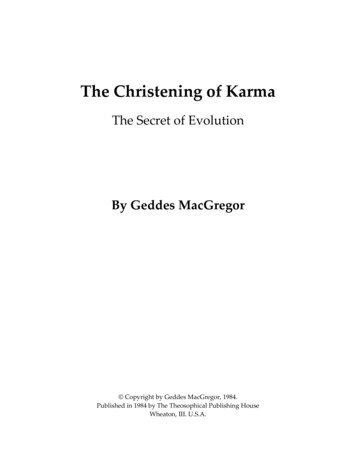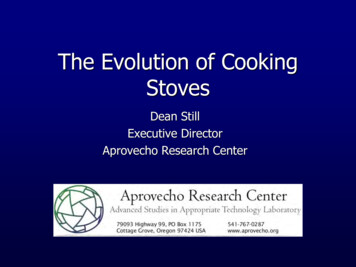
Transcription
The Evolution of CookingStovesDean StillExecutive DirectorAprovecho Research Center
Evolution of Stoves The Open Fire: Hard to Beat! A simplified history:– 1970’s: Any stove must be better than the 3-stone? Lorena story– 1980’s: We need stoves to save fuel Great but emissions were often increased– 1990’s: We need stoves to also reduce IAP! Combustion chambers, high mass chimney stoves increased fueluse, hard to make by hand, etc.– 2000’s: Stoves need to address climate change! Low fuel and emissions, close tolerances, costly– 2010 : Stoves that reduce 1.) fuel 2.) emissions, and are 3.)effective and 4.) accessible !– Better think about it!
The Three-Stone Fire The open fire (out of the wind) has manyadvantages:– Low mass– Radiation helps cook food– Careful tending equals good heat transferefficiency Tami Bond made a 30% efficient fire in her lab– Hot flames touch bottom of pot– No heat is lost into the stove body– Free, traditional, and portable!
Yikes, There are Lots of BadStoves in 2007!!! USAID study in Uganda of stoves madeusing local earthen designs.Table 2: Results of Water Boiling Tests: Average Stove EfficienciesStove typeNo. of testsconductedThermal EfficiencyCold start Hot start Simmering Average8 tests, 4 stoves13.6%14.3%6 tests, 2 fires12.5%13.7%Traditional mud stove 7 tests, 3 stoves10.9%9.3%Trench stove8 tests, 2 stoves8.5%10.1 %Lorena 2-pot (NGO B) 6 tests, 2 stoves7.5%8.8%Lorena 2-oot (NGO A) 6 tests, 2 stoves4.8%4.5%Note: Stoves are ranked by average efficiency over the three test phases.6-brick stove (NGO D)Open 2.0%9.0%6.5%Only one stove just barely beat the three-stone fire in both WBTs and CCTs.
What is an improved stove? The 2005 definition includes the Aprovecho/ShellFoundation benchmarks of fuel use and emissionsperformance: 850g, 20g, 1500mg– Adopted and modified by World Bank, Philips, ARECOP, GTZ, The 2009 definition in the Waxman-Markey Bill is:– Reduces fuel by 50%– Reduces black carbon by 60%– Reduces childhood pneumonia by 30% To meet these requirements, stoves must be carefullyengineered, quality manufactured, and consistentlytested.
Energy to Complete WBT (MJ)028. Battery Powered Fan37. Ethanol38. KeroseneCharcoal36. Propane (LPG)35. StoveTec Wood or Charcoal34. Charcoal Stove with Skirt33. Charcoal JikoFan Stoves32. Mali Charcoal31. Aprovecho Rocket with Fan30. Wood Gas29. Bottom Air Fan StoveGasifiers27. Grid-Powered Fan26. Large Gasifier25. Experimental GasifierRocket Stoves24. Charcoal-Making gasifier23. Previous with Skirt22. StoveTec Wood or Charcoal21. Previous with Skirt20. StoveTec Wood Stove19. Large Baldosa Rocket w/ skirt18. Cast Iron Rocket17. Extra Small Door w/ Skirt16. Two-Pot Rocket15. Short Light Rocket14. Insulated Brick RocketSimple Stoves13. Previous Improved12. Heavy Skirted Rocket11. Previous Improved10. Tall Heavy Skirted Rocket9. Metal Skirted Rocket8. Skirt Stove7. Modified VITA w/ Insulation6. Modified VITA5. Cast Iron Stove from India304. Baldwin VITA353. Mud/Sawdust2. Ghana Wood1. Three Stone FireBenchmarks of Improved StovesEnergy UseLiquid/Gas252015105Hundreds of stoves have been tested in relation to the Shell Foundation benchmarksMore on these Wednesday .
Knowing if a Stove is Improved:Testing Our field has been (is) characterized by little testing andminimal engineering in stoves– Testing in the field of cook stoves has been sporadic and usuallynot third-party– How many times have we heard “Our stove saves 75% of fuel”? Even today, in third-party evaluations, many stoves do not use less fuel compared to the open fire.Eindhoven, Aprovecho, Philips, UIUC, CSU, Iowa State,USAID and other organizations have studied stoves bytesting themStandard testing protocols have been written andrefined, and are starting to take root at organizationsaround the world.Still, when ICS are mentioned in the UN we hearundisguised groans of “Not again”
How is a stove improved? By improving both heat transfer and combustionefficiencies– Good heat transfer requires: High Delta T High velocity High radiation Thin boundary layer by use of small channels near pot(griddle, etc.) Increase area of exposed surface (pot skirt, etc.)– Good combustion has: High temperature Thorough Mixing Fuel Metering and/or preparation
Improved Stoves Today There have been stove “visionaries” whohave created existing solutions: Dr. Samuel Baldwin Dr. Tom Reed Dr. Larry Winiarski Dr. Alexis Belonio
Dr. Samuel Baldwin Dr. Sam Baldwin showed how to increase heat transferefficiency in 1987 in BiomassStoves: Engineering Design,Development, andDisseminationThe use of narrow channelsunder the pot and near theside of the pot withoutrestricting draft resulted inSam’s VITA stove. Dr.Baldwin explored the effectsof mass, materials, etc. in hiswonderful book.
Baldwin’s VITA Stove A simple cylinder of shiny sheet metalaround the pot creating a 10mm gapreduced fuel used to cook dramatically. This successfully reduces fuel, but, as Kirksaid, emissions are not necessarilydecreased. A grate is also used under the fire, liftingthe coals and making fire tending easier.
Performance of VITA StoveForcing the hot gases to pass closely to thesides of the pot reduces fuel use. Adding agrate under the fire reduces CO emissions.Time toBoilFuel UseCOPMEmission %9%ReductionReductionReductionReductionCOST: 4
Dr. Larry Winiarski Larry worked with gasification for a decadebefore deciding that it wastoo finicky for cooks so heinvented the 10 RocketStove Design PrinciplesCommitted to doingsomething good for theworld, Larry’s idea was toclean up combustion thento force hot gases innarrow insulated channelsclose to the pot(s)
Winiarski’s Rocket Stove The Rocket has been studied and tested more than other ICS designs. More than one million “Rocket” stoves havebeen disseminated over 3 decades, although not all havebeen great rocket stoves.The StoveTec stove is an optimized Rocket stove– 90,000 have been sold from Shengzhou Stove Manufacturersince March 2008.– Third party field tests have shown 40% fuel reduction without askirt and reductions of between 50% to 70% of CO and PMemissions. This agrees with in-house lab and field tests.– StoveTec stoves come with a skirt. Will people use a skirt toachieve 50% fuel reduction?– Both StoveTec and Envirofit sell the same stove made byShengzhou Stove Manufacturer. One is green, one is black.
Performance of StoveTec RocketHigher temperatures, mixing, metering andthen forcing the gases against the bottom ofthe pot reduces both fuel use and emissionsTime toBoilFuel UseCOPMEmission %64%ReductionReductionNo SkirtReductionReductionCOST: 8
Dr.’s Reed, Larson, & Anderson Dr Tom Reed and Ron Larson are two folks in the US who for decades have beenexperimenting and making “gasifying” stoves.Many other people are experimenting withgasification from small to large scale.Dr. Paul Anderson and has been promotingnatural draft TLUD stoves.Gasification can be making the gas in one placeand burning it in another place.
TLUD Stoves Generally top lit up draft burning involves limiting the bottom air to a batch loaded fuel supply so that woodburns only on top of the pile with more top air.A TLUD (Top Lit Up Draft) stove is:– batch loaded with dried small pieces of fuel– The wood pile in the can is top lit so the surface of the pile is allon fire– The gases from below must pass through the flame, like acandle, so emissions are reduced. Gasifiers can be very clean burning when operated properlyOur lab has tuned a TLUD made by Paal Wendelbo.When the heat transfer and draft were adjusted, threetests using wood pellets resulted in the following:
Performance of TLUD StovesTLUD results in very little particulate matteremissionsTime toBoilFuel UseCOPMEmission 89%ReductionReductionReductionReductionCOST: 8
Dr. Tom Reed Dr Tom Reed has also pioneered the use of forced air in cooking stovesHis design has been closely followed by Philipsand many other organizationsA 1-3 watt battery driven fan adds a smallamount of air under the batch loaded fuel andalso creates superior mixing above the burningfuelFuel must be prepared/pelletized before useA forced air stove can also shoot jets of air intothe fuel only from below, as seen in thecommercial Canadian fan stove which plugs intothe wall. It costs 225.
Performance of Fan StovesBurning the pellets of fuel with forced air jetsat the bottom and/or top of the combustionchamber creates high velocity mixing whichdramatically decreases fuel use & emissions.Time toBoilFuel UseCOPMEmission %ReductionReductionReductionReductionCOST: 55
Fan Stove: AprovechoThermoelectric Side-Feed The Thermoelectric Side Feed Rocket Stove (prototype in development) is asimple forced air stove using long sticksas fuel.The stove uses a low volume, highvelocity, preheated jet of air to increasemixing above the fire. A 10thermoelectric generator and fanaccessory is attached to the standardStoveTec wood/charcoal stove.Fuel 722 g, CO 5.6 g, PM 150 mgCOST: 25 FOB Ningbo, China!
Dr. Winiarski’s Institutional StovesFuel to Cook 1 Liter, Various Stove Capacities250 Fuel to Cook 1L (g)pot when using a skirt isso powerful that specificemissions for aninstitutional stove rivalforced air stovesCooking large amounts offood can be an extremelyclean and fuel efficientoperation in institutionalsettings200Fuel To Boil 1 Liter15010050045L Institutional10L HouseholdSunken5L Portablew /Skirt5L Portable NoSkirt5L Open FirePM to Cook 1 Liter, Various Stove Capacities500PM to Cook 1L (mg) Heat transfer to a largeFuel to Simmer 1L450PM to Simmer 1L400PM To Boil 1 Liter35030025020015010050045L Institutional10L HouseholdSunken5L Portablew /Skirt5L Portable NoSkirt5L Open Fire
Performance of Institutional StovesTransferring heat to the bottom and sides of avery large pot efficiently uses the heat fromthe fire and emits fewer emissions.Time toBoilFuel UseCOPMEmission Emission3-Stone38125365236360L ionReduction(Data Normalized for 5L)COST: 400
Is My Cool Stove Useful ? Cooks don’t know about the Waxman-Markey bill! Consumer testing is one half of prototype development– Must be consumer tested to ensure appeal and effectivenessbefore dissemination Hard lessons have been learned from worldwide experience: The fact that inventors love their stovesdoesn’t mean that cooks share their passionWBT for design, CCT to check with cooks, then KPT ifyou can afford it
Making Stoves Accessible How are a billion stoves disseminated?– Artisan approach vs. mass production– Commercial vs. philanthropy– Open source vs. trade secrets– Big bank carbon credit financing vs. payingfor and ownership of verified credits– Government programs
In my opinion, price is adetermining factor in dissemination 10 or less can be directly sold to poor people? Then need subsidy: governments, philanthropy, microfinance or carbon creditsCarbon credit projects favor 10 stoves if theysave fuel.Substantial difference between Gold Standardand Waxman-Markey.Optimistic future!
Generally top lit up draft burning involves limiting the bottom air to a batch loaded fuel supply so that wood burns only on top of the pile with more top air. A TLUD (Top Lit Up Draft) stove is: batch loaded with dried small pieces of fuel The wood pile in the can is top lit s
